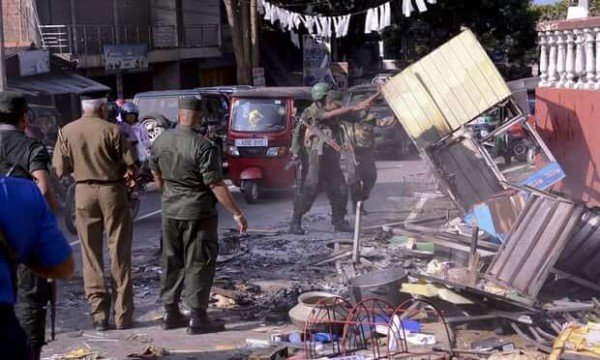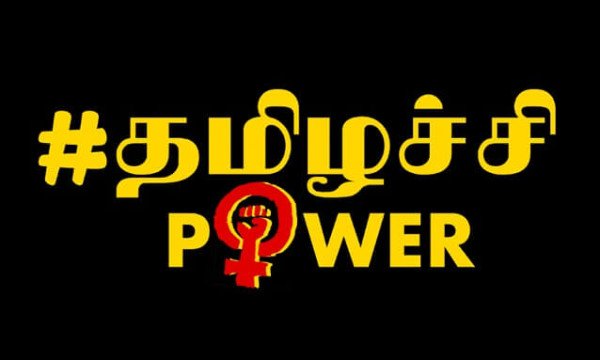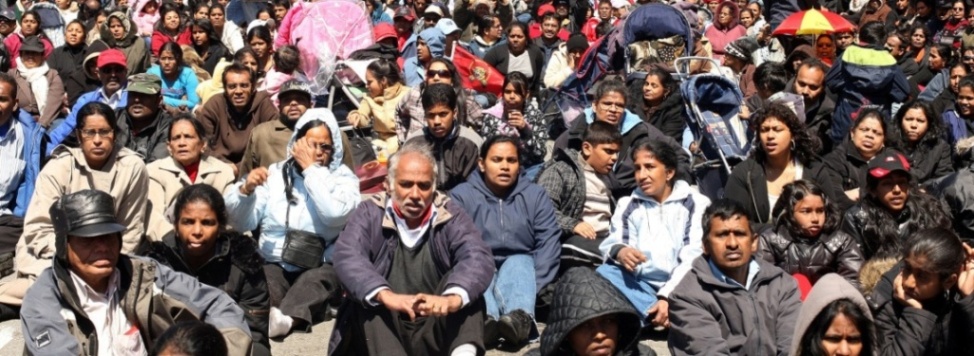
January is Tamil Heritage Month. To mark this occasion, TamilCulture Magazine will publish a series of articles on Tamil history and heritage. Today’s article reflects on the emergence of the Tamil community in Canada.
Even as the majority of Tamils from Sri Lanka arrived in Canada after Black July 1983, there is evidence of migration as early as 1948. In the Canadian Census data over the last several decades, people of Sri Lankan background are divided into three categories of ethnic origin: Sinhalese, Tamils, or Sri Lankans. Surprisingly, as also reflected in the 2006 Canadian Census (see below), most people identified their ethnic origin as Sri Lankan, even though they usually would not identify themselves this way in the country itself (Chandrasekere 2008: 2).
The earliest Sri Lankan migrants to Canada were Burghers, and it is estimated that between 1946 and 1955, about 27 individuals migrated to Canada (Chandrasekere 2008: 11). Sinhalese and Tamils started arriving after 1956, but the numbers remained fairly small, with the total number of immigrants not exceeding 5,000 by 1970. As Chandrasekere (2008: 12-13) points out, these early migrants represented ― only one segment of the Sri Lankan society — the Westernized middle class, most of whom came with enough money to support themselves and their families, as well as with a high level of education. By most scholarly accounts, then, a distinction needs to be drawn between pre-1983 migrants and post-1983 migrants, who were mostly asylum seekers fleeing an increasingly brutal civil war (see Table 1).
Throughout the 1970s and 1980s, changes in Canadian immigration and refugee policy largely facilitated the arrival of many of these post-1983 migrants (Amarasingam 2013: 138-63; Knowles 2007; Dirks 1995). As Wayland makes clear, sympathetic to their plight, Canadian policies facilitated the entrance of Tamils by allowing most Tamil asylum-seekers to bypass one or more stages of the refugee hearing process. The Tamil asylum claims lodged with the Canadian Immigration and Refugee Board between 1989 (when the Board was founded) and 1998 had an average acceptance rate of 85 percent, compared to 60-70 percent acceptance rates overall (2003: 69). Throughout the 1980s and 1990s, tens of thousands of Tamils arrived in Canada and settled in large metropolitan cities like Toronto and Montreal.
This density is not an insignificant theme in our story. The concentration of the Tamil population in Toronto, as well as the broader transnational character of the city, is itself an important aspect of the political context, which allows not only for diasporic identity
formation, but also political mobilisation. As diverse immigrant populations started to repaint the ethnic character of cities like Toronto, settlement services and ethno-cultural organisations also became a well-developed element of these large cities (Preston et.al. 2006:92). Indeed, between 2001 and 2006, seven out of ten immigrants chose to settle in Toronto, Montreal, or Vancouver. In 2006, about 46 percent of Toronto‘s population was foreign born, higher than in Miami (40 percent), Sydney (31 percent), Los Angeles (31 percent), and New York (21 percent) (Kelley and Trebilcock 2000: 419).
Today, Toronto is home to the largest Sri Lankan Tamil population outside of Sri Lanka itself. According to the 2006 Canadian Census, the total population of those who chose either Sri Lankan or Tamil (hereafter SL/T) as their ethnic origin is 138,130 people (see Table 1). This is indeed smaller than Tamil community estimates, which often range from 200,000 to 300,000 Tamils in Canada. One reason for this, as Wayland (2003: 80) has suggested, is that it is quite possible that many recent immigrants simply do not fill out the census forms, possibly as many as half of the population according to some Tamil organizations. I believe, however, that the Census data provides as clear a picture as we can hope for, even while acknowledging much of the limitations.
Indeed, included in the Sri Lankan category could be members of the Sinhalese community, Burghers, Sri Lankan Muslims, as well as other minority groups from the island. Chandrasekere (2008: 18), for example, suggests that perhaps five percent of those who chose Sri Lankan as their ethnic origin are in fact Sinhala language speakers. However, as the vast majority of immigrants and asylum seekers from Sri Lanka have been Tamil, we can be fairly certain that most of those who chose Sri Lankan as their ethnic origin are Tamil as well. In terms of their age, as outlined in Table 1, the majority are under 15 years old or between the ages of 25 and 44 years old. The sex breakdown of the SL/T population is split almost evenly with 51 percent being male and 49 percent female (see Table 2).
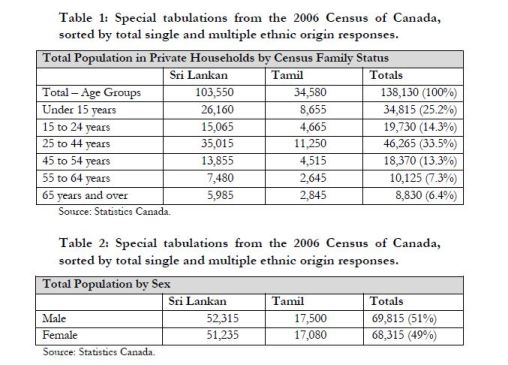
According to the Census data, almost half of the SL/T population in Canada arrived when they were between the ages of 25 and 44 (see Table 3). For the other age groups, the number of immigrants seems to be fairly consistent, ranging from 15 to 20 percent, with only 5.7 percent arriving when they were under the age of five. When considering the period of immigration, it is striking that the number of people who arrived before 1991, between 1996 and 2000, as well as between 2001 and 2006 remains remarkably consistent (see Table 4).
Taking a step back, the Census data also reveals that about 25 percent of the SL/T population was born in Canada, and of these individuals, 92 percent still live in their province of birth (see Table 5). The vast majority, 75 percent, are immigrants, with close to 80 percent of them having received Canadian citizenship (see Table 6).
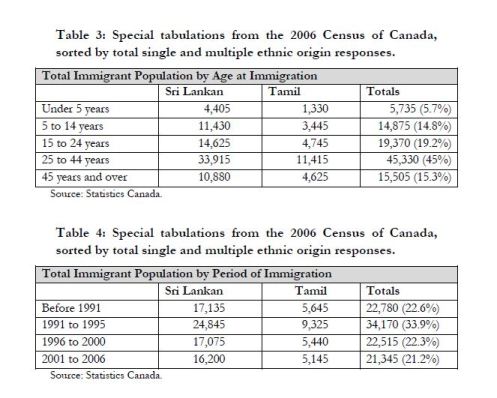
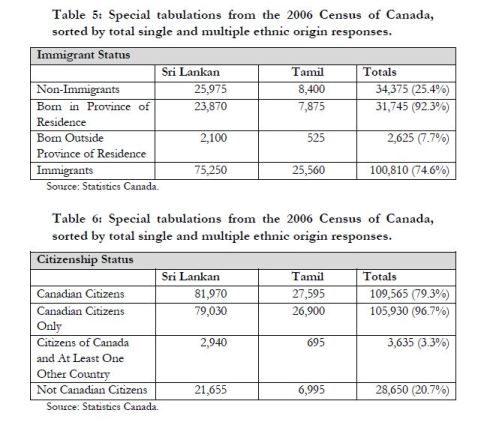
As is well known, the issue of language was one of the main points of contention leading to the outbreak of civil war in Sri Lanka (DeVotta 2004). Many of the older generation of Tamil migrants, of course, carried their language and their culture with them to Canada. They attempted to speak Tamil at home with their children, as well as send them to language training classes to ensure that they did not forget their mother tongue (Amarasingam 2008). However, they soon found it difficult to keep up as their children were learning English at school, and speaking mostly in English with their friends. A remarkable 30 percent of the SL/T population, according to the 2006 Census data, speaks only English at home (see Table 7). Looking closer at the age breakdown of this segment of the population reveals, perhaps unsurprisingly, that 57 percent of them are under the age of 24. Perhaps most interestingly, if we assume that the non-official language that the SL/T population is speaking is Tamil, then around 63 percent still speak their mother tongue at home, while about 7 percent speak a mixture of English and Tamil.
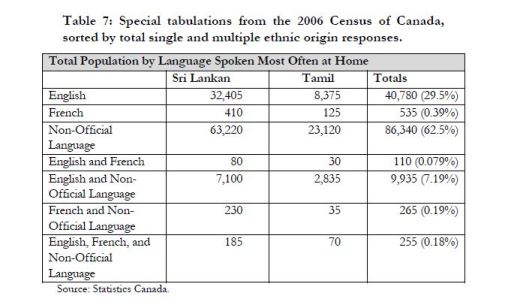
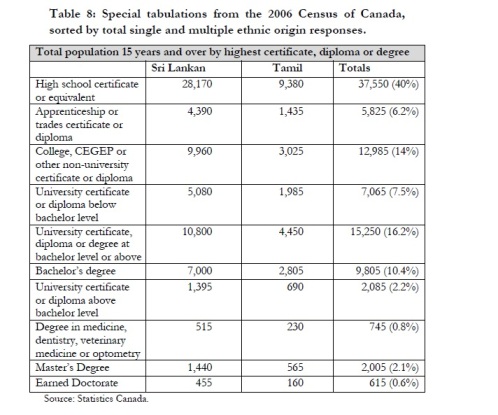
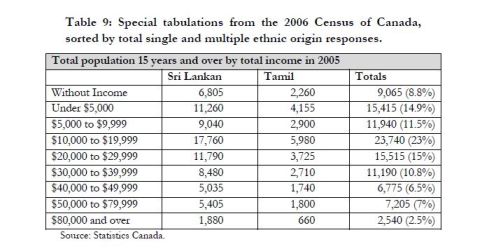
Looking at the Census data with respect to education levels among the SL/T population in Canada, it is clear that 40 percent have at least a high school certificate or equivalent, with another 30 percent holding a college-level or university-level certificate, diploma, or degree (see Table 8). In terms of income levels, 23 percent of the SL/T population in Canada, taking into account that this figure includes a disproportionate number of school-age young people, made between $10,000 and $19,999 in 2005, with around 35 percent having no income or making under $10,000 (see Table 9).
There is, then, a sizable population of Sri Lankan Tamils in Canada, and many in the community have been consistently active in creating lobby groups designed to influence Canadian foreign policy, as well as service-oriented organisations which seek to aid the Tamil community in Canada (see Figure 1). Writing a history of these organisations proved to be immensely time-consuming and difficult. Many of the early organisations, active for many decades, kept little historical records or information about their activities. As such, extensive interviews had to be conducted with early members of these organisations even to obtain a basic summary of when the group was founded, their early lobbying efforts, as well as inter-organisational dynamics. Indeed, on several occasions, members of these organisations expressed gratitude that someone was finally writing this stuff down. While I have attempted to be as accurate as possible, checking and cross-checking much of what is presented below, some inaccuracies may persist. Since I lack the space to thoroughly discuss all of the organisations listed in Figure 1, I limited my focus based on organisational dynamics and identity politics that are of particular relevance to our current discussion.
While Sokefeld‘s argument that diaspora communities are best seen as mobilised entities informs our discussion below, another point is important: diaspora organisations do not exist in a vacuum, simply reacting to events in their native countries. Rather, the character or personality of diaspora groups is often formed relationally through repeated communication and competition with other diaspora organisations (Lacroix 2011; Baubock and Faist 2010). Through these frequent interactions, a kind of negotiated order is achieved (Day and Day 1977; Strauss et.al. 1963). According to negotiated order theory, organisations quite often negotiate the terms under which they will interact with each other in the future, with these relations being subject to changes as new events occur or new parties become involved (Nathan and Mitroff 1991: 165). As discussed below, such a negotiated order has been a large part of the story with respect to Tamil diaspora politics since the 1980s. With the end
of the war in Sri Lanka, much of these negotiations continue, with new and more diverse voices entering the discussion. It is to this that we now turn.
The full report can be read here.
Related: "Tamils by the Numbers"







